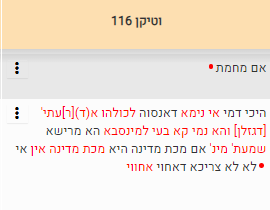An Actual "Lishna Acharina" and its Dating
In yesterday’s daf, Bava Kamma 116:
אִם מֵחֲמַת הַגַּזְלָן – חַיָּיב. הֵיכִי דָמֵי? אִילֵּימָא דְּאַנְסוּהָ לְאַרְעָא דִידֵיהּ וְלָא אֲנַסוּה כּוּלֵּי אַרְעָתָא, הָא מֵרֵישָׁא שָׁמְעַתְּ מִינַּהּ: אִם מַכַּת מְדִינָה הִיא כּוּ׳, אִי לָא – לָא!
§ The mishna teaches: If the thugs took the field due to the robber, the robber is obligated to provide the owner with a different field. The Gemara asks: What are the circumstances of the case in the latter clause of the mishna? If we say that they seized only his land, i.e., the robber’s land, and did not seize all the other lands in the region, you already learned this from the first clause of the mishna: If it is a regional disaster in which the thugs seize all the property in the region, the robber is not obligated to compensate the owner of the field, which indicates that if it is not a regional disaster, the robber is not exempt from payment. What novelty does the latter clause teach?
לָא צְרִיכָא, דְּאַחְוַי אַחְווֹיֵי. לִישָּׁנָא אַחֲרִינָא: הָכָא בְּמַאי עָסְקִינַן – כְּגוֹן דְּאַנְסוּהּ גּוֹיִים, (וְאָמְרִי) [וְאַחְוִי] לֵיהּ אַחְוֹיֵי אַרְעָתֵיהּ, וְאַחְוִי הָהִוא בַּהֲדַיְיהוּ.
The Gemara explains: No, it is necessary for a case where the individual did not actually take control of the property before it was seized by the thugs, but rather showed the field to the thugs and thereby facilitated their occupation of the field. A different version of this answer is as follows: With what are we dealing here? A case where gentiles coerced someone and told him to show them his land for them to seize, and he showed them that field belonging to another, along with his own fields, and the thugs then seized all the land he showed them.
So, there are two versions. In (A) he showed the field to thugs. In (B) he showed his own field, but along with it, his friend’s field.
In the ensuing story, someone showed a field, הָהוּא גַּבְרָא דְּאַחְוִי אַכַּרְיָא דְחִטֵּי דְּבֵי רֵישׁ גָּלוּתָא, and within Rav Nachman’s reply (either uttered by him or inserted from the Talmudic Narrator in his reply) we have וְאוֹקִימְנָא דְּאַחְוִי אַחְווֹיֵי. That seems like A, but maybe it is just the awkward wording of it, and even within B, it is just clarifying what the sparser wording of A really means.
Why am I mentioning this? Because while printings have A and B. Vilna, Soncino and Venice:
However, Florence 8-9 only has A.
Hamburg 165 has only B in the main text, but then A as a marginal note as an alternative.
Thus, in the main body:
then, in a note on the margins, denoted by גר”ש (another girsa?):
Munich 95 has both A and B, with lamed aleph, lishna acharina, between them:
Escorial has A in the main text, then דְּאַחְוַי אַחְווֹיֵי encircled with a circles with tails (like a telisha ketana and gedola) pointing us to a marginal note with the alternative girsa.
Finally, Vatican 116 just has A.
This might tell us something about the phrase, and date, of lishna acharina, a phrase that appears many times throughout the Talmud. (See here.) 214 is an overestimate because they double and triple count occurrences, based on how many “versions” of the text exist on Sefaria, but still, plenty.
We should really explore these comprehensively. In this case, I feel pretty comfortable saying that the two versions are not from Ravina and Rav Ashi as Talmudic redactors, and perhaps not even Savoraic or Geonic. Rather, this arose among scribes, as they copied texts and noted that some written (perhaps even oral, but I think written) texts were slightly different.
Note also that ikka de’amrei to separate between the lishna kamma and lishna batra might be similar and should be explored. I think I saw some examples of those, but didn’t post them on those days when I encountered them. There are kelalei hora’ah. decisive rules, formulated by some Rishonim about which wins, the first or second variant. These might apply to lishna acharina, certainly to ikka de’amrei. And they work based on the assumption that Rav Ashi would have listed the text with primacy first; or that he would have left off with the text he considered primary.
But we should be careful in extrapolating from lishna acharina to ikka de’amrei, and this must be explored separately.












